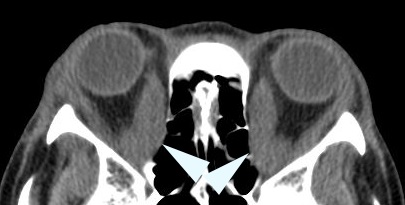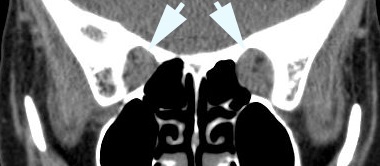Graves Disease
- Autoimmune process that targets the thyroid gland and orbital tissues
- Systemic manifestations include hyperthyroidism and hypothyroidism
- Serum markers include elevated thyroid-stimulating immunoglobulin
- Ophthalmic manifestations are divided into an active (congestive, inflammatory) phase and an inactive (cicatricial, scarred) phase
- Ophthalmic manifestations include lid retraction, lid lag, proptosis, conjunctival inflammation, tearing, ocular misalignment, and optic neuropathy
- Patient reports that the eyes feel tight and uncomfortable but not painful
-
Congestive phase
- Periocular discomfort, tearing
- Upper lid retraction/ lag/swelling, conjunctival chemosis and hyperemia (especially over the extraocular muscle insertions)
- Ocular ductional deficits (especially supraduction, abduction) leading to ocular misalignment causing diplopia
- Proptosis and resistance to retropulsion of the eyes
- Marked extraocular muscle swelling leading to compressive optic neuropathy
- Exposure keratopathy from lid retraction and proptosis
-
Cicatricial phase
- Lid swelling, tearing, conjunctival hyperemia
- Lid retraction, proptosis, exposure keratopathy
- Ocular misalignment from extraocular muscle shortening
-
Possible accompanying features
- Symptoms of hyperthyroidism or hypothyroidism
- Enlarged thyroid gland
- Elevated thyroglobulin antibodies
- Abnormal thyroid function tests
-
Imaging features
- Orbit CT or MRI shows swollen extraocular muscles but normal-sized tendons and sometimes dilated intraconal vessels


- Orbital myositis
- Orbital infection (cellulitis)
- Orbital tumor
- Dacryocystitis (infected lacrimal sac)
- Severe viral or bacterial conjunctivitis
- Cavernous sinus fistula, thrombosis, tumor, inflammation
- Occult orbital trauma
- Ocular motor cranial nerve palsy
- Fisher variant of Guillain-Barré syndrome
- Skew deviation
- Internuclear ophthalmoplegia
- Myasthenia gravis
-
Trap: fungal sino-orbital disease and necrotizing granulomatous polyangiitis may mimic Graves disease and progress rapidly to cause irreversible vision loss
-
Trap: bisphosphonate-induced orbital inflammation may mimic Graves disease
- Treat the congestive phase with decongestants, cold compresses, head-of-bed elevation for sleeping
- Add short-term courses of prednisone if lesser measures do not adequately relieve discomfort
-
Tip: there is no definite evidence that early or sustained treatment with corticosteroids alters the clinical course, but newer immunomodulatory therapy under trial may be effective
- Consider adding x-ray therapy (2,000 cGy) directed at the orbits, which may reduce congestion if corticosteroids do not provide adequate relief
- Perform orbital wall decompression for severe exposure keratopathy or compressive optic neuropathy
-
In the cicatricial phase
- Treat diplopia with spectacle prisms or occluders, opaque contact lens, or extraocular muscle surgery
- Treat upper lid retraction with upper eyelid-lowering surgery
- Orbital imaging abnormalities are often overlooked because standard brain imaging does not provide adequate views of the orbit
- Lid edema, conjunctival hyperemia usually lessen within 2 years of onset
- Upper eyelid retraction, proptosis, ocular misalignment, diplopia may persist
- Spectacle prisms may relieve diplopia, but incomitance usually causes failures, leading to the use of occluders
- Orbital wall decompression is often effective in preventing or reversing optic neuropathy and may relieve proptosis
- Eye muscle surgery is often effective in relieving diplopia
- Eyelid surgery often relieves exposure keratopathy and the blemish of “bug eyes”
-
Trap: orbital wall decompression may create or worsen diplopia and may rarely induce vision loss by damaging the optic nerve
